phpMyAdmin is a PHP application that provides a complete interface to manage MySQL databases over the Web. The following image depicts the product's home page; the main sections — MySQL and Web server — indicate that phpMyAdmin relies on a PHP-enabled web server to send commands to a MySQL server and receive data from the server:
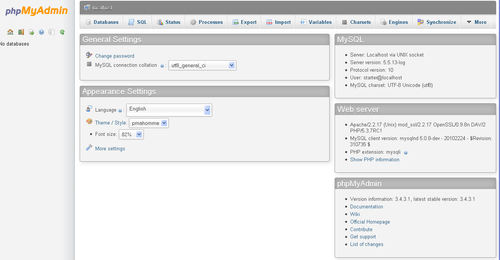
As MySQL is the database of choice on the Web and PHP is a popular web scripting language, web host providers often provide phpMyAdmin for their users as the de facto mechanism to administrate their databases.
Users of phpMyAdmin can be broken down into these categories:
The authors of other web applications often advise administrators to use phpMyAdmin, either for initially populating the required database, or as a back entry in case they are locked down from their application.
phpMyAdmin offers panels to manage the structure of data: creating, editing, deleting various elements like databases, tables, columns, indexes, views, and foreign keys (relations). The software also enables you to deal with the data itself: inserting, editing, and deleting data; sorting; searching in tables or databases; importing and exporting to various file formats.
A system administrator can also use phpMyAdmin to acquire status information about the MySQL server; this information can be used to fine-tune the server. Moreover, maintenance of MySQL usernames and privileges is available.
Advanced functions include:
Generating system documentation, including table relations in graphical form
Transforming data (for example to show a thumbnail of an image stored as a BLOB (Binary Large Object); see http://dev.mysql.com/doc/refman/5.5/en/blob.html)
Tracking changes on structure and data
Keeping bookmarks of frequently-used queries
Maintaining users' preferences about phpMyAdmin's settings
Synchronizing databases between servers
Volunteers all over the world help the development team by providing translations for the interface in many languages.
In four easy steps, you can install phpMyAdmin and get it set up on your system.
Before you install phpMyAdmin, you will need to check that you have all of the required elements, as listed below:
phpMyAdmin requires a web server environment that supports PHP, for example Apache (http://httpd.apache.org/) or IIS (http://www.iis.net/).
25MB free (minimum) disk space on the web server. You will require more free space to store your data in MySQL.
phpMyAdmin is written in the PHP scripting language. phpMyAdmin v 3.4.x requires a minimum of PHP v5.2.0.0 to run.
The minimum supported MySQL version is 5.0.x.
You need MySQL account information (username, password)
The recommended way to download phpMyAdmin is as a compressed package from http://phpmyadmin.net/. We suggest that you download the most current stable build.
Pick a file which has an extension for which you have the corresponding extractor program. Moreover, there are packages which contain only the English message files and other packages, marked all-languages, which contain all supported languages. Let's suppose you downloaded phpMyAdmin-3.4.3.1-all-languages.zip and saved it to your local workstation.
After downloading and unpacking this archive, you will be left with a directory called phpMyAdmin-3.4.3.1, containing a number of files and folders.
The main configuration file is named config.inc.php and its normal location is the top-level directory (where index.php is located). A single instance of phpMyAdmin can manage many MySQL servers; therefore, this file can contain sections for more than one MySQL server. It can also contain directives that control the behavior of the interface. All these directives are explained in Documentation.html.
If this file is not found, phpMyAdmin assumes that you want to connect to a MySQL server on localhost—the same host as the web server. This might fit your purpose.
It's recommended to use the sample configuration file, config.sample.inc.php, and copy it over config.inc.php; then, look it over and follow the examples therein.
Using the uploading mechanism available on your web server, you should now place the whole folder in your web server documents directory, in which case the tool will be located at http://yourwebserver.com/phpMyAdmin-3.4.3.1. The exact location and URL really depends on your host's policies.
You can rename the folder; however, the final name it should bear depends on a number of factors:
Is there more than one phpMyAdmin version installed on the server?
Is this a multi-user installation, where users are accustomed to call it by a special URL like
http://yourwebserver.com/mysql?
The following examples will assume that the folder was renamed to phpMyAdmin.
By this point, you should have a working installation of phpMyAdmin and are free to play around and discover more about it.
Now that the folder is in place on the web server, you can use a web-based setup script to refine your configuration. The advantage of configuring this way is that all directives are conveniently regrouped by menus and submenus, such as Features, Navigation frame, and Import.
Visiting http://yourwebserver.com/phpMyAdmin/setup displays the following initial screen:
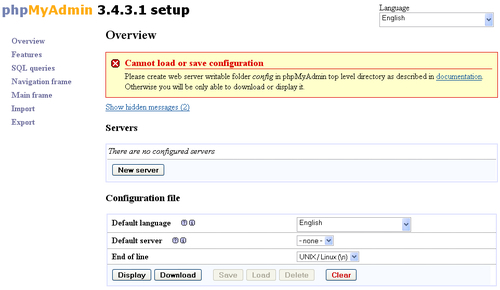
At this point, you are able to use the various menus and buttons—notably the New server button—to explore the configuration possibilities. You'll note that the setup script cannot currently load or save a configuration file. This is because a protection mechanism exists. If anyone could visit this URL and configure phpMyAdmin, your installation would be at risk. Therefore, you need to have access to the folder where you installed phpMyAdmin, to create a subfolder named config which can be used temporarily during the configuration steps. The web server itself must have the rights to write to this folder.
When this subfolder has been created, reload the page; now you can use the Save button and this creates a config.inc.php under the config subfolder.
After configuration is done, you need to do the following:
Copy the newly created
config.inc.phpto the top-level directory this makes it the effective configuration.Change the permissions on the copied
config.inc.phpto ensure that the web server cannot write to it.Delete the
configdirectory (or at least change its permissions to avoid any writing in it)
phpMyAdmin is all about managing MySQL tables, so this section guides you in creating a database to hold your new project, then creating two tables.
The theme for the sample tables is a grocery store, with departments and items. Of course an information system for a real grocery store would contain many more tables describing employees, suppliers, and sales but two tables will suffice for our purpose.
We suppose here that your MySQL username is sarah and that this account is allowed to create databases with the prefix sarah_.
A MySQL database is a container for tables. The new database will be named sarah_grocery, assuming that the system administrator enforces the policy that all databases must have the username as a prefix. The rest of the database name consists of the project name, which here is grocery.
Currently you might be seeing one existing database, information_schema. This is not a real database but contains metadata about the whole data structure.
Log in to MySQL via phpMyadmin's login panel, with the username sarah.
Click on the Databases menu tab.
Change the database name from sarah_.... to sarah_grocery.
Click on the Create button.
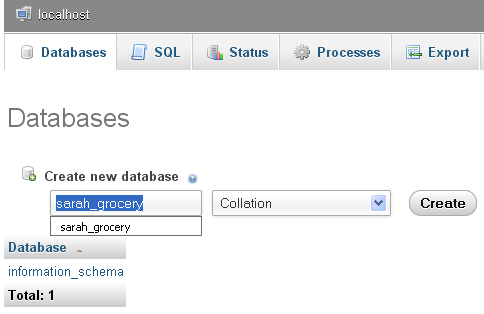
You must now tell phpMyAdmin to use sarah_grocery as the current database. This way, all actions will take place in the context of this database. The easiest way to open it is by clicking on the database name from the navigation panel (which is located on the left-hand side if you are using a left-to-right language like English).
Now that you have a database to play with, it's time to create a table that will hold the description of the grocery's departments. To be able to create inter-table relations in a later task without the need for installing further phpMyAdmin elements, all the tables in this exercise will use the InnoDB storage engine—see http://www.innodb.com and http://dev.mysql.com/doc/refman/5.5/en/innodb-storage-engine.html.
InnoDB is a good choice for the storage engine, as it offers solid performance, transactions, referential integrity, and crash recovery.
When opening a database, you are by default in its Structure page where you can see existing tables and views belonging to this database. You now use the Create table initial dialog to specify the table name and initial number of columns:
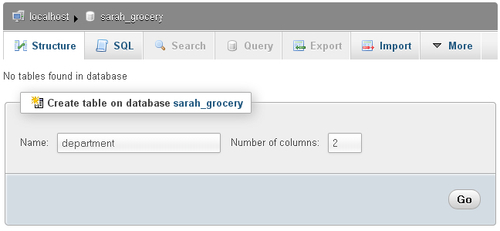
Clicking on Go brings up the columns panel where you'll create two columns, id (an integer column) and description (a variable-size character column having a maximum length of 100). The id column is marked as being the primary key.
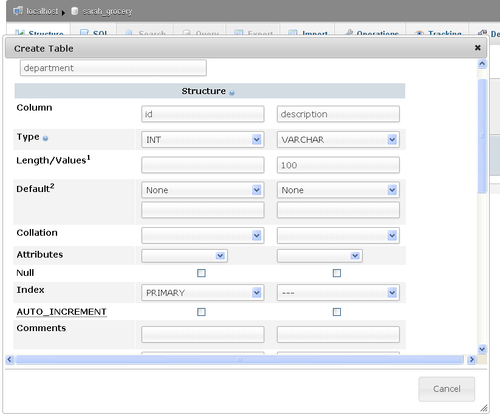
Scrolling to the bottom of this panel and clicking Save creates the table. You now see a different Structure panel, which shows the existing table, department, on which you can apply actions, and the Create table dialog to create further tables.
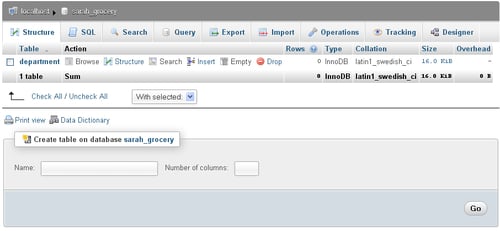
You will now use your table creation skills to create the item table, containing the following columns:
id (an integer and primary key)
dept_id (an integer)
description (VARCHAR 100)
weight (an integer)
You will notice that both tables have a column id as the primary key; however, there is no risk of confusion because SQL requires using the table name in queries, such as the following:
SELECT id FROM item
You need some sample data to play with these tables. There is more than one way of inserting data into a table:
In the current step you'll use the Insert menu, which can be reached from the database Structure page. Let's begin by inserting new departments; on the line for the department table, click on Insert, which brings the insertion panel. Then enter this sample data:
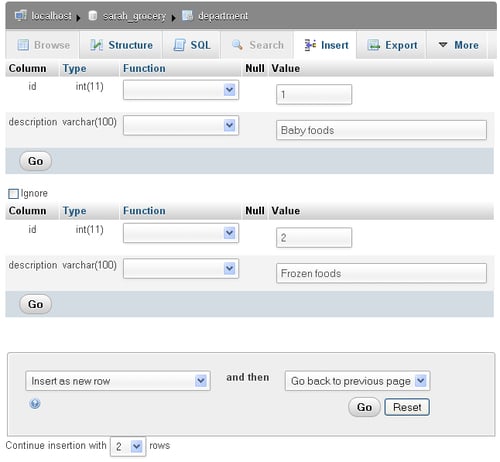
Clicking on Go generates the following query, sends it to the MySQL server and displays it on-screen—this is handy, both to reassure you about the action done and possibly to teach you SQL.
INSERT INTO `sarah_grocery`.`department` (`id` ,`description` ) VALUES ( '1', 'Baby foods' ), ( '2', 'Frozen foods' );
You need to also populate the item table. Here you create two items in the frozen foods department:
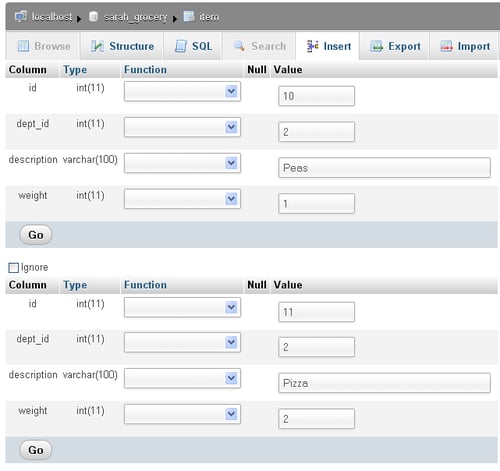
As you start to use phpMyAdmin, you will realize that there are a wide variety of things that you can do with it. This section will show you the most commonly performed tasks in phpMyAdmin and how to do them.
Probably the most common usage of phpMyAdmin is to look at data. In fact, this is so common that the default action when clicking on a table name in the navigation panel is to browse this table.
Let's see what appears when you click on the department table from the navigation (left) panel:
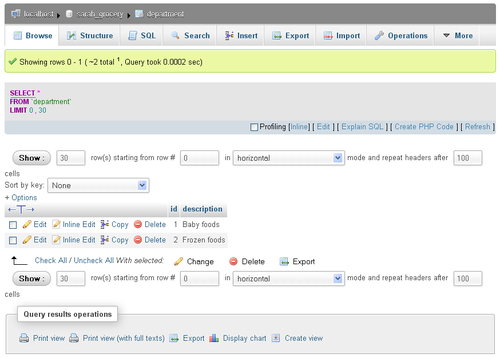
The screen in browse mode can be broken down into various sections, which are explained here, from top to bottom:
The server / database / table locator
The table menu, with Browse being highlighted
The Showing rows line, indicating which rows you are looking at (first row being numbered 0) and the total number of rows
The generated query SELECT * FROM `department` LIMIT 0,30
A navigation line, from which you could specify how many rows you want and the starting row
A Sort by key selector, containing all the indexes for this table from which to choose to sort
An Options link (more on this below)
A big T that enables you to show the full text of lengthy columns
The names of the columns (clickable to sort on each column)
The data lines, prefixed with checkbox action links Edit, Inline Edit, Copy, and Delete
A With selected line, permitting to perform global actions on the lines for which the corresponding checkbox has been marked
The Query results operations section, from which you can generate a Print view of the table, Export the results, or generate a chart from the data
Clicking on Options opens a sliding section, offering you more ways of displaying the data for BLOB columns, binary columns, or relational information:

Browsing is not just looking at raw data; phpMyAdmin can also sort this data. Sorting can be performed on an index, using the Sort by key selector, or simply by clicking on a column header. Clicking again on the same header reverses the sort. You can experiment now by clicking twice on the description header.
When there are numerous rows of data, they are presented by pages and you can navigate back and forth between these pages. Here is an example of navigation controls with a different table, taken from MySQL's sakila database (http://dev.mysql.com/doc/sakila/en/sakila.html):

For small tables like your department and item tables, it's often sufficient to browse them in order to grasp all their data. However, for larger projects involving many tables or many data rows, you have to rely on phpMyAdmin's search mechanisms.
You can search on a single table or on many tables at once. Let's begin by examining the single-table case, using the item table.
You can enter the table Search page with either of these methods:
Opening the
sarah_grocerydatabase on its Structure page and clicking the Search link on the line corresponding to the item tableOpening the item table and clicking the Search menu tab
The initial search page looks like the following, with only the most commonly-used "query by example" section visible:
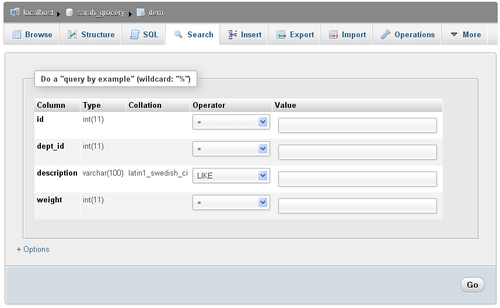
In a query by example search, you fill one or more values corresponding to what you are looking for. You can also apply an operator to a value in order to modify the search behavior.
Let's search for some pizza; for this, you simply enter pizza (with a lowercase p) in the value field next to the description; then you click on Go, which brings the following results screen:
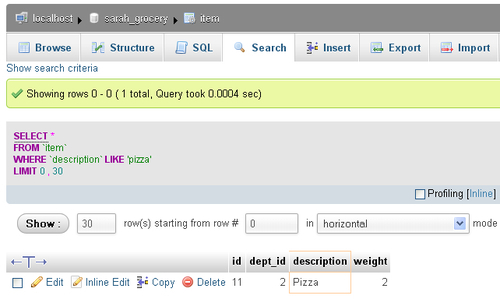
A few remarks about this screen:
We entered pizza but MySQL found Pizza; this is because the
descriptioncolumn uses one of the case-insensitive collations (latin1_swedish_ci, wherecimeans case-insensitive)The description column in the results is highlighted with a colored border
We are now in a normal results panel and all the possibilities related to browsing are available (page navigation, sorting, and so on)
The search criteria panel has been hidden but can be brought back using the Show search criteria link located just under the menu tabs
To practice using a search operator:
Click on Show search criteria.
Enter 10 as a value for id.
Change the operator on the id column, to less than (<).
Click on Go.
No item with a description of Pizza and an id less than 10 exists, so you get the MySQL returned an empty result set (i.e. zero rows) message.
The search Options slider contains controls to restrict which columns will appear in the results, to ask for distinct results, to type in a WHERE clause, to specify the number of rows per page and to choose the display order.
Now you'll have a look at the multi-table (or database) search mechanism. This searching method is handy when you are not sure of the exact table that holds a piece of data you are looking for, or when the same piece of data (say, a city name) appears in more than one table or more than one column.
Opening your database and clicking on Search brings the database search panel. You'll first try an exact search for the number 1, in all tables. To accomplish this search:
Enter 1 as the value to search.
Tick the radio button next to the exact phrase.
Click Select All to pick all tables.
Click on Go.
The following image depicts the search panel just before launching the search:
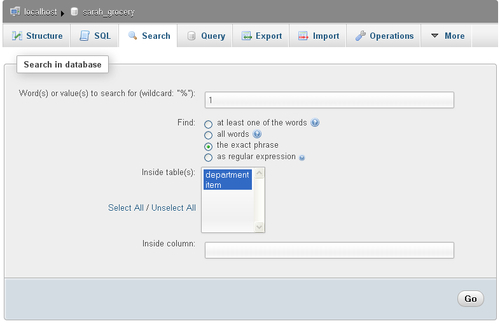
The search results first give an overview of the number of matches for each table, as well as links to browse or delete these matches:
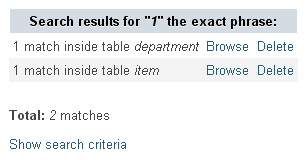
Clicking on Browse fetches the search results for a particular table, while leaving the global search results on the top of screen.
Note that the Show search criteria link is available. You now click on this link and change the search mode (in the Find dialog) from the exact phrase to at least one of the words. Clicking on Go shows different global search results with two matches inside the item table. The reason for this is the addition of the wildcard % character before and after the searched value in the generated query, which now matches the id 10 and 11 of the item table when looking for the number 1.
Heraclitus, a Greek philosopher (and probably database designer precursor) told us that "Nothing is permanent except change". In the database world, not only data values often change but also their supporting structures (column, table, view, and database definitions).
You'll first explore the three graphical methods for editing data, and then you'll go on about changing data structure.
When you have a results page (generated by either browsing a table or searching in it), you notice that for each data row, Edit and Inline Edit links are offered. Moreover, a checkbox appears for each line, permitting you to choose the rows to edit via the Change link underneath.
Let's try the Edit link for the item table. Browsing this table and clicking on Edit for id 10 brings this row in edit mode. Here you have changed the weight value from 1 to 3 and are about to click on Go to save the change:
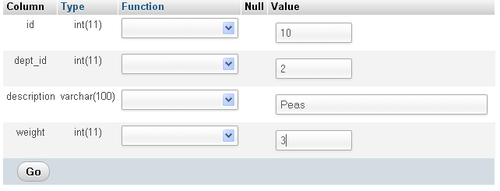
This is the most traditional mechanism to edit a row. Using the checkboxes and the With selected: Change link permits you to put more than one row in the edit mode at once. Here are some reasons why you might want to do this:
To compare data from one row to another while editing
To copy and paste data from one row to another (for example, exchanging the weight value between peas and pizzas)
More recently (in phpMyAdmin 3.4.x), inline editing was made available. Trying it for id 10 brings you this screen:

The advantage is that you did not leave the results page you were on; thus you can keep an eye on the data for the other rows, which can help you decide about the changes to make.
Directly make your changes and click on Save, or decide to Hide the inline edit view, therefore not saving any changes you made.
We will now explore how to modify the structure of data. You begin by opening the department table in Structure — mode this can be done either by clicking Structure for this table, or by clicking the small icon next to this table name in the navigation panel.
The Structure page shows you a great deal of information:
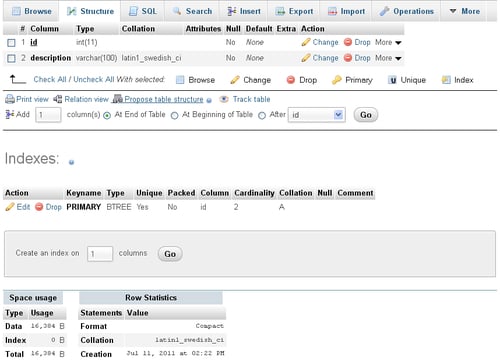
You can see three main sections:
The list of current columns, with a dialog to add more
The Indexes section, where you can edit or drop an index
The statistics about space usage and rows
In the next exercise you will add a column that will be used to record the date of the last inspection for this department. In the dialog Add X column(s) you see that the default is to add one column at the end of the table; then just click on Go, bringing up the following panel in which you type the new column's information:
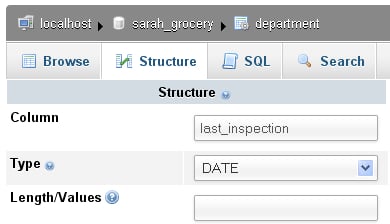
Clicking on Save adds this column to your table. You can now browse the department table and notice that there is a new column, last_inspection, with all the dates set to 0000-00-00 as we did not set any default date.
Editing an existing row shows you a new icon: a small calendar. Clicking on it gives you a standard date picker, shown as follows:
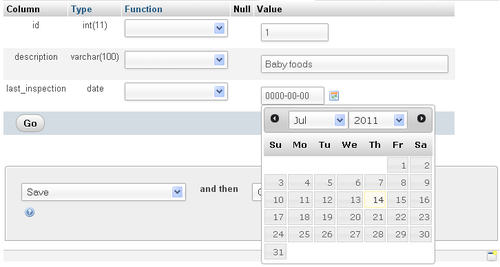
You can also change an existing column's structure—for example, the description column becoming a VARCHAR(110)—but beware of the consequences, should you change the type or size of the column. Data truncation could happen.
Adding an index on the last_inspection column can be done quickly via the More menu that is offered for each column:
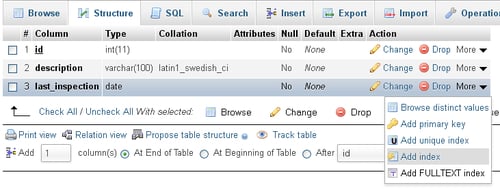
Fine-tuning indexes is accomplished via the Indexes section by using the Edit link for a specific index. Here you can add or remove columns from an index, or even change the number of characters a column uses in this index.
The popularity of Excel means that many people are familiar with this tool and they prefer to do the majority of their data manipulations in it. This task will describe extracting data with the goal of reading it back into Microsoft Excel. Note that any utility that understands the CSV (comma-separated values) format can be used to read the file generated in this task.
You'll first practice exporting in quick mode, and then you'll go through the custom mode for additional options.
Start by opening the department table and clicking Export, which brings up this panel:
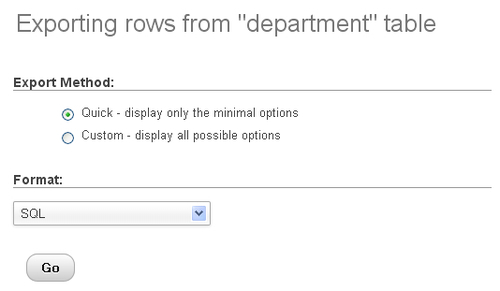
As can be seen, the default export format is SQL because it permits you to quickly produce a complete backup of the table's structure and data. However for this task, you need to change the export format to CSV for MS Excel.
A pure CSV file should use Comma-Separated Values; however as Excel uses semicolons to delineate each value, phpMyAdmin produces a file containing semicolons. You can try this format by choosing it in the Format selector and clicking Go. Your browser offers to save the file or to open it with the default program associated with .csv files (depending on your workstation's OS). Here is what you can see after opening the file with Excel:

Note that in this quick export format, the column names do not appear; you’ll use the custom format to remediate to this.
Contrary to the quick export format, the custom one offers many options. Some of these options (Rows, Output) are common for all export formats and some are adapted for each format.
Selecting CSV for MS Excel, and then choosing Custom produces the following panel:
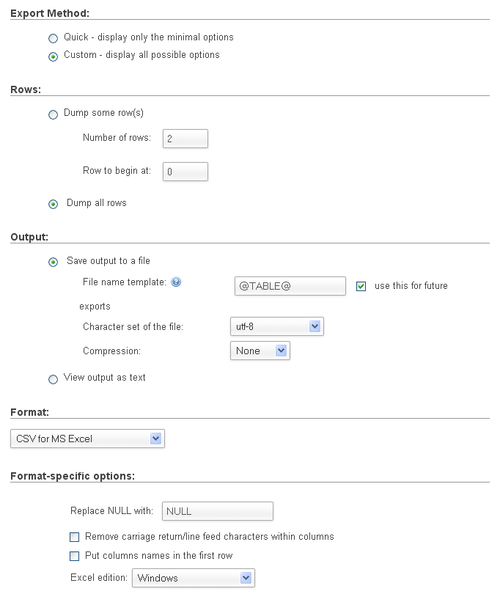
The Rows section enables you to choose to Dump (export) just some rows (with the number of rows and starting row) or all rows.
The Output section permits you to either save output to a file (with a choice of character set and compression) or to view the output as text (which would not save anything but can be useful in case the output format can be interpreted as text — this happens to work with the CSV format).
Next, the format-specific options vary according to the chosen format. Here, the option most likely to be changed would be Put column names in the first row. This would help the person opening the CSV file in Excel to see column headers indicating the original column names.
There is also a selector to pick up which Excel edition is the target for this file (Windows, Mac).
Making relations between tables is very useful. Let's just consider the benefits of defining relations when manipulating tables via phpMyAdmin:
The possibility of choosing the values of one column, based on a related table
A clearer description of the relations between tables
The possibility of generating a schema of the relations
The native way in MySQL to define relations is via the FOREIGN KEY constraints (more details at http://dev.mysql.com/doc/refman/5.5/en/innodb-foreign-key-constraints.html). These constraints are available with the InnoDB storage engine; this is why we created our tables under this engine.
In this task, you'll begin with exploring what can be done with relations using just what MySQL offers natively; then you'll learn the additional possibilities offered by phpMyAdmin, thanks to its configuration storage mechanism.
The goal here is to make a relation between the dept_id column of the item table and the id column of the department table; this is because a department should exist before you use it in the item table. In InnoDB vocabulary, the foreign key for item.dept_id will be department.id.
You first open the item table on its Structure page and then click on Relation view. This produces the following panel:
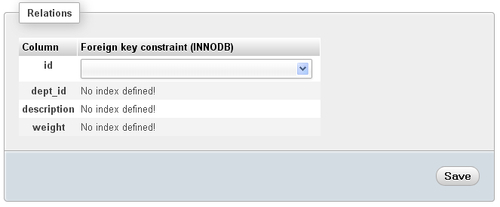
InnoDB requires that all columns referring to a foreign key or referred to as a foreign key, have an index defined. So you must go back to the Structure page for item and, for the dept_id column, use the More selector and choose Add index:
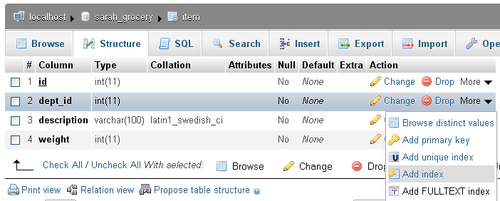
Going back to the Relation view, you can now choose for dept_id the appropriate column department.id. Choosing it makes other selectors appear as well:

The ON DELETE and ON UPDATE are foreign key options; they are explained in the aforementioned MySQL documentation page. For now you'll just keep the default values and click on Save.
At this point, everything went fine because your data respected the constraint (department IDs existed in the department table).
You can immediately see a benefit of the relation by trying to Insert a new item; the possible department IDs appear in a drop-down selector:
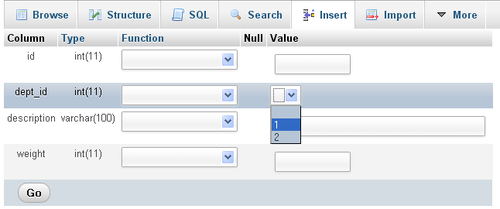
More options can be made available if your installation has the phpMyAdmin configuration storage deployed. In short, this is a special set of tables that contain metadata about various configuration elements. For example, we would like to see the department name in the drop-down selector, when we insert or edit an item. Thus, the metadata called display column is offered in the phpMyAdmin configuration storage, to hold which column best describes each row. Details about installing the configuration storage appear in Documentation.html. The remaining segments of this task assume that the configuration storage has been installed.
With this in place, you can open the department table in Structure page, click Relation view, and pick the column to display, which is description:

After clicking on Save, you can now open the item table in Insert mode and see the difference, shown as follows:
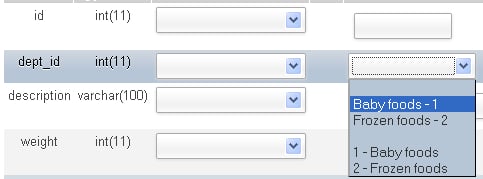
If too many rows were present in the referenced table, an icon would be offered instead of a drop-down. This icon would open a distinct panel to select among the values, with pagination and search capabilities.
Another handy feature made available by the configuration storage is the Designer. In this panel, available from the database menu, you can define the relations graphically, move the tables around on the workspace, and save their coordinates in order to produce a PDF schema of the relations. The following is an image of the Designer's workspace:
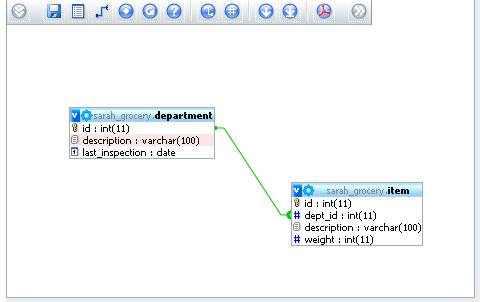
If you need help with phpMyAdmin, here are some people and places which will prove invaluable.
Homepage: http://phpmyadmin.net
Manual and documentation: http://phpmyadmin.net/documentation (this contains the documentation for the latest development version;
Documentation.htmlis the current documentation for your version and is included in the downloaded kit)Wiki: http://wiki.phpmyadmin.net contains information for both the users of phpMyAdmin and its developers
Blog: http://planet.phpmyadmin.net aggregates the blogs of some phpMyAdmin developers
Source code: phpMyAdmin is always offered in source code, but you'll find more information about the repositories at http://www.phpmyadmin.net/home_page/improve.php
Learning SQL using phpMyAdmin http://www.php-editors.com/articles/sql_phpmyadmin.php
Doing more with phpMyAdmin (parts 1 and 2): http://www.devshed.com/c/a/PHP/Doing-More-With-phpMyAdmin-Part-1, http://www.devshed.com/c/a/PHP/Doing-More-with-phpMyAdmin-Part-2
Support home page: http://www.phpmyadmin.net/home_page/support.php
Official mailing list: for users: https://lists.sourceforge.net/lists/listinfo/phpmyadmin-users;
for developers of phpMyAdmin: https://lists.sourceforge.net/lists/listinfo/phpmyadmin-devel
Official forums:
https://sourceforge.net/projects/phpmyadmin/forums/forum/72909Official IRC channel: #phpmyadmin on irc.freenode.net
Microblogging: http://identi.ca/phpmyadmin, the project's official microblogging site
Facebook:
http://www.facebook.com/pages/PhpMyAdmin/157021164334486Ohloh: The page http://www.ohloh.net/p/phpmyadmin tracks phpMyAdmin's progress in terms of the source code changes
Producers of the popular XAMPP system which includes phpMyAdmin: http://twitter.com/#!/apachefriends
Quick news about phpMyAdmin: http://twitter.com/#!/phpmya
For Open Source news: http://twitter.com/PacktOpenSource




















